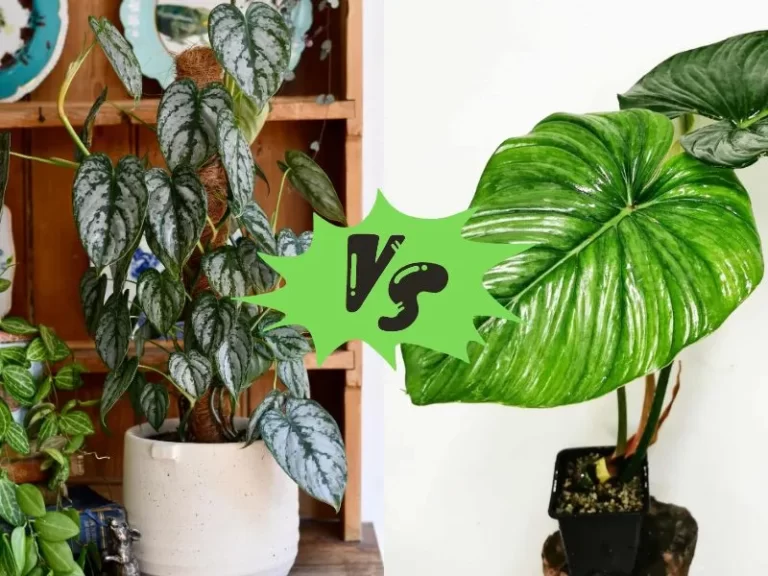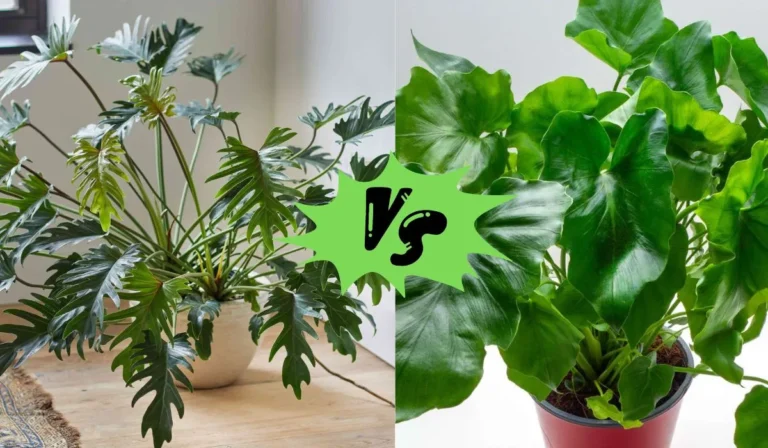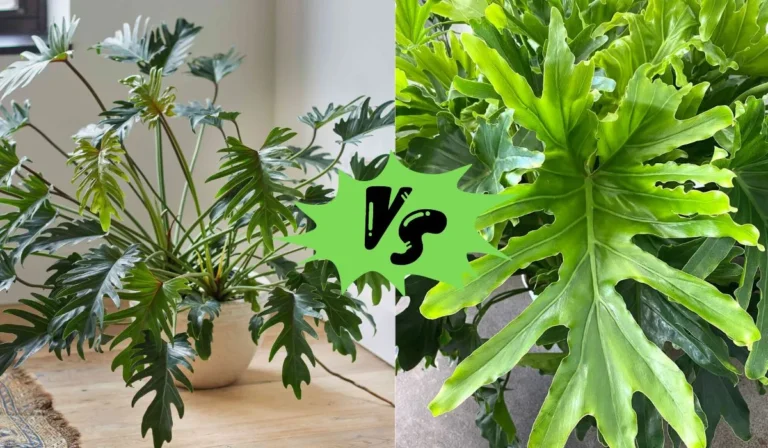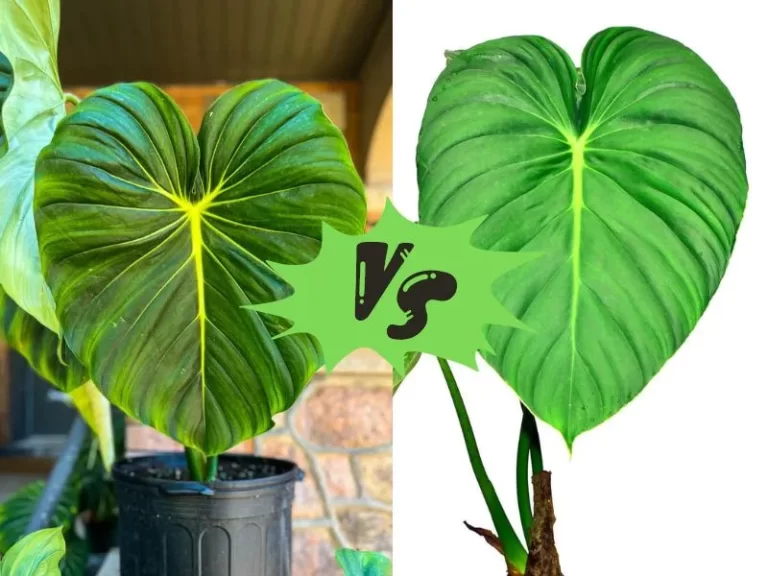Alocasia Gageana vs Macrorrhiza: Which is the Best Fit for Your Home?
Are you interested in learning about the differences between Alocasia gageana and Alocasia macrorrhiza? Both of these plants are members of the Araceae family and are commonly known as elephant ears. While they share some similarities, there are also distinct differences between the two species that are worth exploring.

Alocasia gageana and Alocasia macrorrhiza are both tropical plants that are popular for their large, striking leaves and easy-to-care-for nature. However, there are differences in their leaf shape, size, and coloration that set them apart from one another.
Additionally, there are differences in their preferred growing conditions, which can impact their overall health and vitality. By understanding these differences, you can choose the best plant for your needs and ensure that it thrives in your home or garden.
Key Takeaways
- Alocasia gageana and Alocasia macrorrhiza are both tropical plants with large, striking leaves.
- The two species differ in their leaf shape, size, and coloration, as well as their preferred growing conditions.
- Understanding these differences can help you choose the best plant for your needs and ensure that it thrives in your home or garden.
Understanding Alocasia Gageana

Alocasia Gageana, also known as Dwarf Elephant Ear, is a stunning tropical plant that belongs to the Araceae family. If you’re looking for a plant that can add an exotic touch to your indoor space, Alocasia Gageana is an excellent choice. In this section, we’ll discuss the origin and habitat, characteristic features, cultivation, and care of Alocasia Gageana.
Origin and Habitat
Alocasia Gageana is native to Southeast Asia, specifically Malaysia and Borneo. It grows in the rainforests, where it thrives in warm and humid conditions. In the wild, Alocasia Gageana can reach up to 6 feet in height.
Characteristic Features
Alocasia Gageana is a small-sized plant that can grow up to 2 feet in height. It has glossy, heart-shaped leaves that are dark green in color. The leaves are held on long petioles that emerge from an underground corm. The plant produces white, spadix-like flowers, but they are not particularly showy.
Cultivation and Care
Alocasia Gageana is a relatively easy plant to care for, making it an ideal choice for beginners. The plant prefers bright, indirect light and well-draining soil. It can tolerate some direct sunlight, but too much can scorch the leaves.
Water the plant when the top inch of soil feels dry, and mist the foliage regularly to increase humidity. Alocasia Gageana is sensitive to cold temperatures and should be kept in a warm environment.
In summary, Alocasia Gageana is a beautiful and easy-to-care-for plant that can add a touch of the tropics to your indoor space. With the right conditions and care, you can enjoy this stunning plant for years to come.
Exploring Alocasia Macrorrhiza

Alocasia Macrorrhiza, commonly known as Giant Taro or Elephant Ear, is a popular plant among indoor and outdoor gardeners. This plant is native to Southeast Asia and belongs to the Araceae family.
Botanical Profile
Alocasia Macrorrhiza is a tropical perennial plant with large, heart-shaped leaves that can grow up to 3 feet in length and width. The plant can reach a height of 6 feet when grown in optimal conditions. Its stem is thick and can grow up to 4 inches in diameter.
Distinctive Traits
One of the distinctive traits of Alocasia Macrorrhiza is its massive size. The plant’s leaves are enormous, making it a popular choice for gardeners who want to create a tropical atmosphere in their gardens or homes. The leaves are also glossy and have a deep green color, which adds to the plant’s appeal.
Another distinctive trait of Alocasia Macrorrhiza is its ability to purify the air. The plant can remove toxins such as formaldehyde, benzene, and xylene from the air, making it an excellent choice for indoor environments.
Growing Requirements
Alocasia Macrorrhiza requires a warm and humid environment to thrive. It prefers well-draining soil and requires regular watering to keep the soil moist but not waterlogged. The plant also requires bright, indirect sunlight to grow properly.
If you’re planning to grow Alocasia Macrorrhiza indoors, you can use a humidifier to increase the humidity levels in the room. You can also mist the plant’s leaves regularly to keep them moist and prevent them from drying out.
Comparative Analysis
Visual Differences
When it comes to visual differences between Alocasia gageana and macrorrhiza, there are a few key things to look out for.
A. gageana has leaves that are typically more elongated and narrow than those of A. macrorrhiza. Additionally, A. gageana has a closed sinus, meaning there is no split where the petiole meets the leaf, while A. macrorrhiza has an open sinus. The color of the leaves can also vary, with A. macrorrhiza having a more greenish color and A. gageana having a more silvery-green hue.
Growth Habits
In terms of growth habits, both A. gageana and macrorrhiza can grow to be quite large. However, A. macrorrhiza tends to grow taller and wider than A. gageana. A. macrorrhiza can also be more invasive, as it has a tendency to spread through underground rhizomes. On the other hand, A. gageana is generally more clumping and does not spread as aggressively.
Care and Maintenance
When it comes to caring for A. gageana and macrorrhiza, there are a few things to keep in mind. Both plants prefer well-draining soil and bright, indirect light. However, A. macrorrhiza can tolerate lower light conditions than A. gageana. Both plants also prefer high humidity levels, so it may be necessary to mist them regularly or use a humidifier. Finally, it’s important to note that both A. gageana and macrorrhiza are toxic to pets and humans if ingested, so be sure to keep them out of reach.
Overall, Alocasia gageana and macrorrhiza are two visually stunning plants with some key differences in terms of their growth habits and care requirements. By understanding these differences, you can choose the right plant for your space and ensure that it thrives for years to come.
Common Issues in Cultivation
Pest and Disease Management
When it comes to pest and disease management for Alocasia Gageana and Macrorrhiza, prevention is key. Make sure to keep the plants clean and free of debris, as this can attract pests and diseases. If you do notice any issues, it’s important to act quickly to prevent them from spreading.
Common pests include spider mites, mealybugs, and scale insects. To control these pests, you can use insecticidal soap or neem oil. For diseases, it’s important to remove any infected leaves and treat the plant with a fungicide.
Environmental Stress Factors
Alocasia Gageana and Macrorrhiza are sensitive to environmental stress factors such as temperature, humidity, and light. These plants prefer warm temperatures between 60-85°F (15-29°C) and high humidity levels. If the air is too dry, you may notice brown tips on the leaves.
To increase humidity, you can use a humidifier or place a tray of water near the plant. Alocasia plants also prefer bright, indirect light. Direct sunlight can scorch the leaves, while too little light can cause the plant to become leggy. If you notice your plant is not thriving, it may be due to environmental stress factors.
Remember to keep an eye on your Alocasia plants and address any issues as soon as possible. With proper care and attention, these plants can thrive and add beauty to your home or garden.
Propagation Techniques
Alocasia Gageana Propagation
If you want to propagate your Alocasia Gageana, there are a few techniques you can use. One of the most popular ways is through division. To do this, gently remove the plant from its pot and separate the roots into smaller sections. Make sure each segment has both roots and growth buds.
Then, plant each section in its own pot with well-draining soil and keep it moist. Another way to propagate Alocasia Gageana is through corms. Corms are bulb-like structures that grow underground. To propagate through corms, carefully remove them from the parent plant and plant them in their own pots with well-draining soil.
Alocasia Macrorrhiza Propagation
Propagating Alocasia Macrorrhiza is similar to propagating Alocasia Gageana. You can use the same techniques of division and corms. When dividing the plant, make sure each segment has both roots and growth buds before planting it in its own pot with well-draining soil.
When propagating through corms, carefully remove them from the parent plant and plant them in their own pots with well-draining soil. Another way to propagate Alocasia Macrorrhiza is through stem cuttings. Take a stem cutting with a few leaves and plant it in moist soil. Keep the soil moist until the cutting has rooted and is growing well.
Overall, propagating Alocasia Gageana and Alocasia Macrorrhiza is relatively easy. Just make sure to use well-draining soil and keep the soil moist. With a little patience and care, you can have a thriving collection of Alocasia plants in no time!
Landscaping and Decorative Uses
When it comes to landscaping and decorative uses, both Alocasia gageana and macrorrhiza can add a tropical touch to your garden or indoor space. Alocasia macrorrhiza’s large, glossy leaves can create a stunning focal point in a garden bed or in a large container. It can also be used as a statement piece in a room with high ceilings and bright, indirect light.
On the other hand, Alocasia gageana’s smaller size and more compact growth habit make it a great choice for smaller spaces or as an accent plant in a larger display. Its striking leaves, which can reach up to 2 feet in length, are a beautiful shade of green with prominent veins.
Both plants prefer well-draining soil and regular watering, but Alocasia gageana can tolerate slightly drier conditions than macrorrhiza. In terms of temperature, Alocasia macrorrhiza prefers warmer temperatures, while Alocasia gageana can tolerate cooler temperatures.
Overall, both Alocasia gageana and macrorrhiza can add a touch of the tropics to your landscaping or indoor decor. Consider your space and lighting conditions when deciding which plant is right for you.
Tips for Plant Enthusiasts
If you’re a plant enthusiast looking to add Alocasia to your collection, here are a few tips to help you care for your plants:
- Choose the right soil: Alocasia plants prefer well-draining soil that retains moisture without becoming waterlogged. You can use a mix of peat moss, perlite, and sand to create the perfect soil mix for your plants.
- Water your plants regularly: Alocasia plants require regular watering to thrive. You should water your plants once a week, making sure to keep the soil moist but not waterlogged. You can also mist the leaves of your plants to increase humidity.
- Provide enough light: Alocasia plants require bright, indirect light to grow well. You should place your plants near a window that receives plenty of light but is shaded from direct sunlight.
- Fertilize your plants: Alocasia plants benefit from regular fertilization. You can use a balanced fertilizer every two weeks during the growing season to help your plants grow strong and healthy.
- Watch out for pests: Alocasia plants are susceptible to pests like spider mites and mealybugs. You should inspect your plants regularly for signs of infestation and treat them promptly if you notice any pests.
By following these tips, you can help your Alocasia plants thrive and grow into beautiful additions to your indoor garden.
Frequently Asked Questions
How do I care for Alocasia gageana compared to Alocasia macrorrhiza?
Both Alocasia gageana and Alocasia macrorrhiza require similar care. They need well-draining soil, bright indirect light, and high humidity. However, Alocasia gageana is more tolerant of lower light conditions than Alocasia macrorrhiza.
What are the size differences between Alocasia gageana and Alocasia macrorrhiza?
Alocasia gageana is smaller than Alocasia macrorrhiza, with leaves that typically grow up to 2 feet in length. Alocasia macrorrhiza, on the other hand, can grow up to 8 feet tall with leaves that can reach up to 3 feet in length.
Can Alocasia gageana and Alocasia macrorrhiza be grown together, and if so, how?
Yes, Alocasia gageana and Alocasia macrorrhiza can be grown together in the same pot or container. Make sure the container is large enough for both plants, and that the soil is well-draining. Water both plants evenly and ensure they receive adequate light.
What is the difference between Alocasia gageana, macrorrhiza, and odora in terms of growth and care?
Alocasia gageana, macrorrhiza, and odora all require similar care, but they differ in terms of growth and appearance. Alocasia gageana is smaller in size with leaves that are more arrow-shaped. Alocasia macrorrhiza is larger in size with leaves that are more heart-shaped. Alocasia odora has leaves that are more elongated and have a distinct point at the tip.
Is there a variegated variety of Alocasia macrorrhiza, and how does it differ from the standard form?
Yes, there is a variegated variety of Alocasia macrorrhiza called Alocasia macrorrhiza variegata. The variegated variety has leaves that are marbled with tones of light green and white blotches. It requires similar care to the standard form.
What is the expected growth size for Alocasia gageana ‘California’?
Alocasia gageana ‘California’ is a cultivar of Alocasia gageana that has smaller leaves than the standard form. It typically grows up to 1-2 feet in height.






